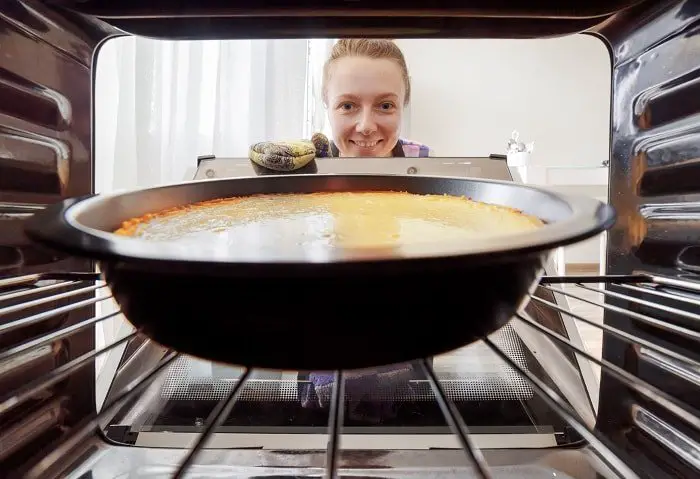It’s always nice to have a crowd-pleasing, simple, versatile dessert recipe at the ready. Cheesecake is ideal for keeping on hand because it freezes well and pairs beautifully with many different sauces. And what’s even better, you can bake your cheesecakes perfectly every time with proper temperature control. We have the thermal tips you need for the best homemade cheesecake.
There are two different baking methods that yield very different textures. Which method should you choose? It depends on whether you want a traditional cheesecake that’s creamy and silky-smooth or a contemporary one with a more substantial texture. Or make one of each! Keep reading to find out which best suits your preferences.
A cheesecake is done when the center just barely jiggles. Since this can be difficult to judge, try this tip. Cheesecake is ready to come out of the oven when the internal temperature reaches 150 degrees. (At higher temperatures, the texture will suffer.)

Baking temperature determines the texture
Cheesecake is a custard, and custards can overcook easily. Overbaked cheesecake will crack and the texture will be dry and gritty. Egg proteins become quite firm and tightly coiled when cooked quickly at a high temperature, but can be silky-smooth and creamy when cooked gently at a low temperature. There are two different baking methods that each yield very different results. Both are very good, and which to use depends on your personal preference.
For a lighter cheesecake with a toasty browned top, bake it in a three-step process.
- First, bake it at 450°F (232°C) for about 20 minutes.
- Then turn the oven off and prop the door of the oven door open (a wooden spoon is good for this) for 10 minutes, allowing it to vent some of its heat.
- Then turn the oven back on, set the baking temperature to 250°F (121°C), close the door, and finish baking.
For a dense, pale cheesecake, simply bake it in a 250°F (121°C) oven the entire time. The slower, gentler heat will not cause the steam-induced oven spring that occurs in the high-off-low method above and the cheesecake will remain quite dense.
Be careful not to overbake
Regardless of the desired density of your cheesecake, bake it until the egg protein is perfectly set, and not a degree longer. The longer the cheesecake remains in the oven after it has reached its pull temperature, the tighter the egg proteins will become, and the greater the likelihood of your cake cracking.
Pull the cheesecake from the oven when the internal temperature of the center reaches 145°F (63°C) as verified with an instant-read thermometer like the Thermapen® Mk4. Start checking the internal temperature about 10 minutes before the suggested baking time is up to be sure you don’t overbake.
A super-fast instant-read thermometer like the Thermapen® makes it easy to perform multiple quick checks without leaving the oven door open too long.
Jiggle test
This inaccurate method of tapping the side of the pan to see if the side of the custard is set while the center is still slightly jiggly does not test against a reliable standard—it’s far too subjective and will vary from person to person.
Crack test
Some people wait until the top of the cheesecake cracks as a cue to its doneness. But by the time the cheesecake cracks, it’s already overdone, and it will crack more when it cools! Testing the internal temperature is the best method to know exactly when to pull the cheesecake from the oven so as not to overcook the delicate egg protein.
How to Tell if your Cheesecake is Cooked | Cook with Curtis Stone | Coles
FAQ
What should the internal temp of a cheesecake be?
Is 350 too hot for cheesecake?
What temperature should cheesecake be cooked at?
Instead of using a knife or toothpick, try gently shaking the cheesecake. The center should have a slight jiggle while the edges are set. Another method is to insert a thermometer into the center of the cheesecake. The internal temperature should reach 150°F (65°C) for a fully cooked cheesecake. Pay attention to the color of the cheesecake.
Is cheesecake a healthy food?
Vegan cheesecake has healthy ingredients and can be adjusted according to food preferences. A recipe with rice milk and seeds is a great suggestion.
How do you cool a cheesecake?
Let it cool slowly. Let the cheesecake sit in the turned-off oven with the door cracked for one hour, remove it from the water bath and let it cool completely on the stovetop, then chill in the fridge overnight. Now, let’s break down how to make cheesecake into easy pieces.
How do you test a cheesecake?
Stick the probe halfway into the cake—a baked cheesecake should read 150ºF. However, testing cheesecake this way can mar the finish on top. You worked hard to create this cake, so we don’t blame you if you don’t want to go poking holes in it. That’s where this second technique comes in.
